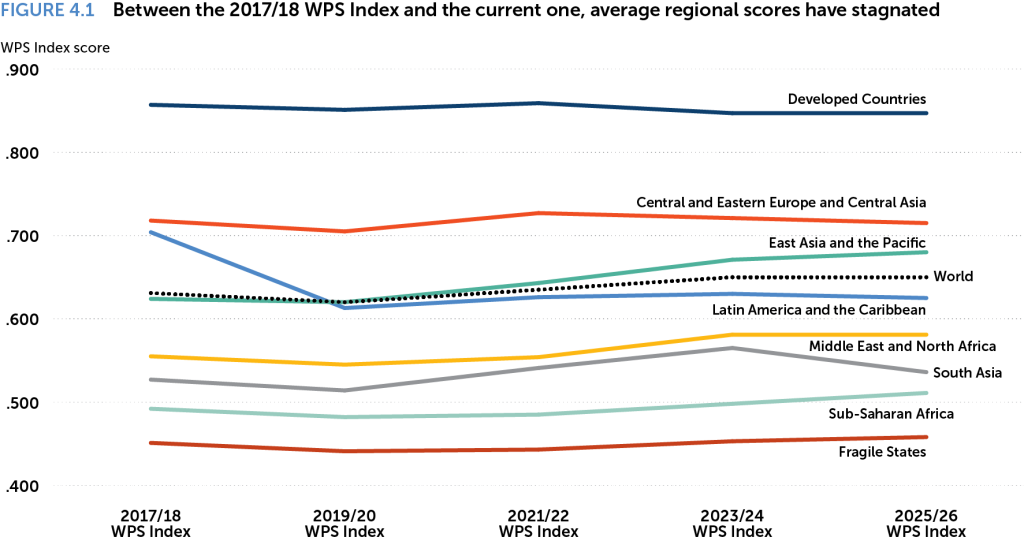Key Takeaways
- Global progress on women’s status has stagnated around the world since the first Women, Peace and Security Index in 2017.
- Developed countries, states in Latin America and the Caribbean and states in Central and Eastern Europe and Central Asia have all experienced stagnation or backsliding in women’s status.
- More women than ever live close to conflict that negatively affects their rights, but some conflict-affected countries have seen some improvements in women’s status.
Denmark remains the best country to be a woman, according to the 2025-2026 Women, Peace and Security Index.
The biennial index ranks 181 countries across 13 indicators to measure the status of women, from their representation in legislative bodies to maternal mortality rates and financial inclusion. The report is produced by the Georgetown Institute for Women, Peace and Security (GIWPS) and the Peace Research Institute Oslo.
The Nordic country retained its top spot since the 2023 rankings, and Afghanistan ranked lowest again. The U.S. moved up six spots to 31st place, driven in part by the country’s first improvement in maternal mortality rate in almost two decades, based on data up until the end of 2024.
The findings of the report come at a time of relative backsliding for women’s status around the world, said Haleema Hasan (G’24), the lead author of the report.
“Regional scores of the WPS Index — a multidimensional measure of women’s status — show largely flat trends since 2017, with some groups even declining. That’s a pretty alarming result.”
Discover a few of the takeaways from the report, including how different regions fared and signs of hope for the future of women.
Where Progress Has Stalled
In developed countries, progress in women’s rights has stalled despite overall high scores, the report found. Countries in Central and Eastern Europe and Central Asia declined overall in women’s status despite being the second-best performing group behind developed countries.
In Latin America and the Caribbean, women’s status has also declined. Hasan said factors like specific policies that affect women in these countries as well as security indicators, such as proximity to conflict and political violence targeting women, have contributed to this trend. The region also has the highest rate of political violence targeting women out of all the regions and country groups in the index.
However, for the first time, two countries in the region, Costa Rica and Uruguay, cracked the top 20% of the index. Hasan said the two outliers have climbed the rankings after sharp recoveries from setbacks affecting women and consistent small gains to improve women’s rights.

Regions With Positive Gains
Despite declines in parts of the world, the report highlights three regions where the status of women has experienced gains.
Countries in East Asia and the Pacific have continued to trend upward for women. However, many countries in the region still have significant gaps in women’s education, parliamentary representation and maternal mortality, according to the report. The region performs worst globally on son bias, an indicator that measures preference for male children and discrimination against girls and women.
“While there are ups and downs, [East Asia and the Pacific] has had a largely positive trajectory.”
Meanwhile, countries in sub-Saharan Africa and those classified as Fragile States have seen the largest gains in women’s status since the first index in 2017, despite facing significant setbacks and ongoing challenges.
Decline and Hope in Conflict Zones
Conflict around the world has been a major driver in the decline of women’s status. According to the report, a record 676 million women were exposed to conflict in 2024, a 74% increase since 2010.
“The societies where women’s status is higher are also societies that are less likely to be fragile and more likely to have positive peace. The reverse is also true,” Hasan said.
Hasan noted that women living close to conflict also suffered on several other fronts. For example, political violence targeting women is three times worse than the global average in countries that score at the bottom of proximity to conflict, Hasan said.
The report shows some improvement for women in conflict-affected countries. For instance, Hasan noted Yemen has experienced some of the largest gains in inclusion scores compared to other countries, while the Republic of Congo has seen the largest improvement in overall scores since the first index in 2017. However, score increases have not translated to changes in many countries’ Index rankings because they still have a long way to go.
These improvements should encourage further action to improve women’s lives in these challenging contexts, Hasan said. She also said that researchers need to dig deeper in conflict-affected areas to better understand women’s experiences and how, in some cases, they are able to make improvements amidst incredibly difficult circumstances.
“I think it’s such a hopeful result. That’s not to say that the conditions in these societies are not adverse, challenging or catastrophic in so many cases, but the fact that despite those circumstances, we’re seeing improvements,” she said. “It challenges these notions that these countries are bereft of any sort of progress on women’s status. This result is not meant to comfort but compel people into action – if women are not giving up in incredibly difficult contexts, how can the rest of us?”


